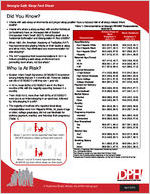Georgia Safe Sleep Fact Sheet
Did You Know?
Infants with safe sleep environments and proper sleep position have a reduced risk of all sleep-related infant
deaths1.
Table 1: Characteristics of Georgia PRAMS1 Respondents,
Infants who share a sleep surface with another individual
2004-2013
(or bedshare) have an increased risk of Sudden Unexpected Infant Death (SUID), including death due to Accidental Suffocation and Strangulation in Bed (ASSB)2.
Characteristic
Always Sleep on Back
Weighted % (95% CI2)
Never Bedshare
Weighted % (95% CI2)
Since 1992, the American Academy of Pediatrics (AAP) has recommended placing infants on their backs to sleep and since 2005, has eliminated any recommendation for side sleeping3.
Race/Ethnicity Non-Hispanic White Non-Hispanic Black Non-Hispanic Other3
63.3 (61.0, 65.5) 45.4 (42.7, 48.1) 53.3 (49.0, 57.5)
46.8 (44.5, 49.1) 21.7 (19.5, 24.0) 29.7 (25.9, 33.7)
The AAP expanded their recommendations in 2011 to include providing a safe sleep environment and promoting room share, not bed share4.
Hispanic Maternal Age (Years)
< 20 20-24
54.7 (47.9, 61.2) 30.1 (24.4, 36.5)
45.7 (41.6, 49.7) 55.8 (54.1, 57.4)
19.6 (16.6, 23.0) 34.5 (33.0, 36.1)
Who Is At Risk?
35 Maternal Education
61.7 (57.9, 65.4) 43.4 (39.6, 47.3)
Sudden Infant Death Syndrome (SIDS)/SUID is common among infants that are 2-4 months old. However, babies can die of SIDS/SUID until they are 1 year old.
< High School High School Graduate Some College College Graduate
47.4 (43.9, 50.8) 52.2 (49.5, 54.8) 54.4 (51.4, 57.3) 65.2 (62.4, 67.8)
21.2 (24.2, 30.4) 30.8 (28.4, 33.3) 31.9 (29.2, 34.8) 45.7 (42.9, 48.5)
In 2014, most (90%) of SIDS/SUID are in the first 6
Payment for Delivery
months of life with the majority occurring between 2-4
Medicaid
50.0 (48.0, 52.0) 25.9 (24.2, 27.7)
months.
Not Medicaid
61.5 (59.5, 63.5) 42.7 (40.7, 44.7)
From 2009-2013, more than half (52%) of SIDS/SUID were due to an infant sleeping in an adult bed, followed by 18% sleeping in a crib5.
The majority of mothers who reported ideal sleep
Marital Status Married Other
Rurality Urban
60.8 (58.9, 62.6) 48.5 (46.3, 50.7)
42.0 (40.2, 43.8) 23.8 (22.0, 25.8)
56.4 (54.6, 58.1) 35.2 (33.5, 36.8)
characteristics were non-Hispanic White, 35 years of age
Rural
53.4 (50.6, 56.2) 32.3 (29.7, 34.9)
or older, college graduates, did not use Medicaid for
Pregnancy Intention
delivery payment, married, and intended their pregnancy
Intended
61.7 (59.6, 63.9) 38.4 (36.2, 40.6)
(Table 1).
Unintended Ever Breastfeed
52.8 (50.5, 55.0) 24.9 (23.0, 27.0)
Yes
58.8 (57.1, 60.4) 33.7 (32.1, 35.3)
No
47.5 (44.9, 50.2) 35.1 (32.6, 37.6)
Alcohol Use
About 1 out of 3 moms reported that their infant NEVER shared a sleep surface with anyone.
Any4 Never Smoking Status
62.0 (59.8, 64.2) 51.3 (49.5, 53.1)
33.3 (31.2, 35.6) 34.3 (32.7, 36.1)
Any5
54.1 (50.6, 57.5) 29.5 (26.4, 32.7)
About 1 out of 5 moms reported that they ALWAYS lay their infant sleep on their back.
Never
55.6 (54.1, 57.2) 34.9 (33.4, 36.4)
1PRAMS = Pregnancy Risk Assessment Monitoring System 2CI = Confidence Interval 3Non-Hispanic women of a race other than White or Black 4Alcohol use 3 months before pregnancy or during last trimester 5Tobacco use 3 months before pregnancy, during last trimester, or at time of survey
2 Peachtree Street, Atlanta, Ga 30303 | dph.ga.gov
April 2016
Georgia Safe Sleep Fact Sheet
Safe Sleep in Georgia
The number of children under 1 year of age that die from a sleep related cause such as SUID, suffocation, entrapment or asphyxia has remained fairly constant in the State of Georgia.
The overall percent of mothers who reported always putting their infants to sleep on their back peaked in 2008 and has slightly declined since then (Figure 1).
The overall percent of mothers who reported that their infant never bedshares has steadily increased from 2004 to 2013 (Figure 1).
Figure 1: Safe Sleep Characteristics by Year Georgia PRAMS (2004-2013)
58.9
58.6
60.0
59.0
55.8
55.7
56.0
53.1
39.6
39.1
% 27.8
27.3
26.5
32.9
30.9
28.8
46.5
48.9
46.9 43.8
2004
2005
2006 2007 2008 2009 2010 2011
Always Sleep on Back
Never Bedshare
2012
2013
References
1. Centers for Disease Control and Prevention. (2015). Sudden Unexpected Infant Death (SUID) Fact Sheet. www.cdc.gov/sids/pdf/sudden-unexpected-infant-death.pdf. 2. Salm Ward, T. C., Robb, S. W., & Kanu, F. A. (2016). Prevalence and Characteristics of Bed-Sharing Among Black and White Infants in Georgia. Maternal And Child Health
Journal, 20(2), 347-362.
3. American Academy of Pediatrics. (2011). SIDS and other sleep-related infant deaths: Expansion of recommendations for a safe infant sleeping environment. Pediatrics,
128(5), 10301039.
4. Moon, R. Y. (2011). SIDS and other sleep-related infant deaths: expansion of recommendations for a safe infant sleeping environment. Pediatrics, 128(5), e1341-e1367. 5. Georgia Bureau of Investigation. 2013 Child Fatality Review Annual Report.
Safe Sleep PRAMS Survey Questions and Response Choices: 1. How do you most often lay your baby down to sleep now? On their side, on their back, or on their stomach 2. How often does your new baby sleep in the same bed with you or anyone else? Always, Often, Sometimes, Rarely, or Never
NOTE: Respondents were only asked to choose ONE answer
The Georgia Safe Sleep Fact Sheet is published as new data become available by the Office of Strategy and Epidemiology, Maternal and Child Health Section, Division of Health Promotion, Georgia Department of Public Health. See suggested citation below. For data requests, please apply through the Public Health Information Portal in Georgia DPH at dph.georgia.gov/phip-data-request
Suggested Citation
Georgia Department of Public Health. Safe Sleep Fact Sheet, Georgia, 2004-2013 https://dph.georgia.gov/PRAMS. Published April 2016, Accessed [date]
FOR MORE INFORMATION Georgia Department of Public Health Maternal and Child Health Section at 404-657-2850 Email: Florence.Kanu@dph.ga.gov
dph.georgia.gov/MCH
We Protect Lives.
